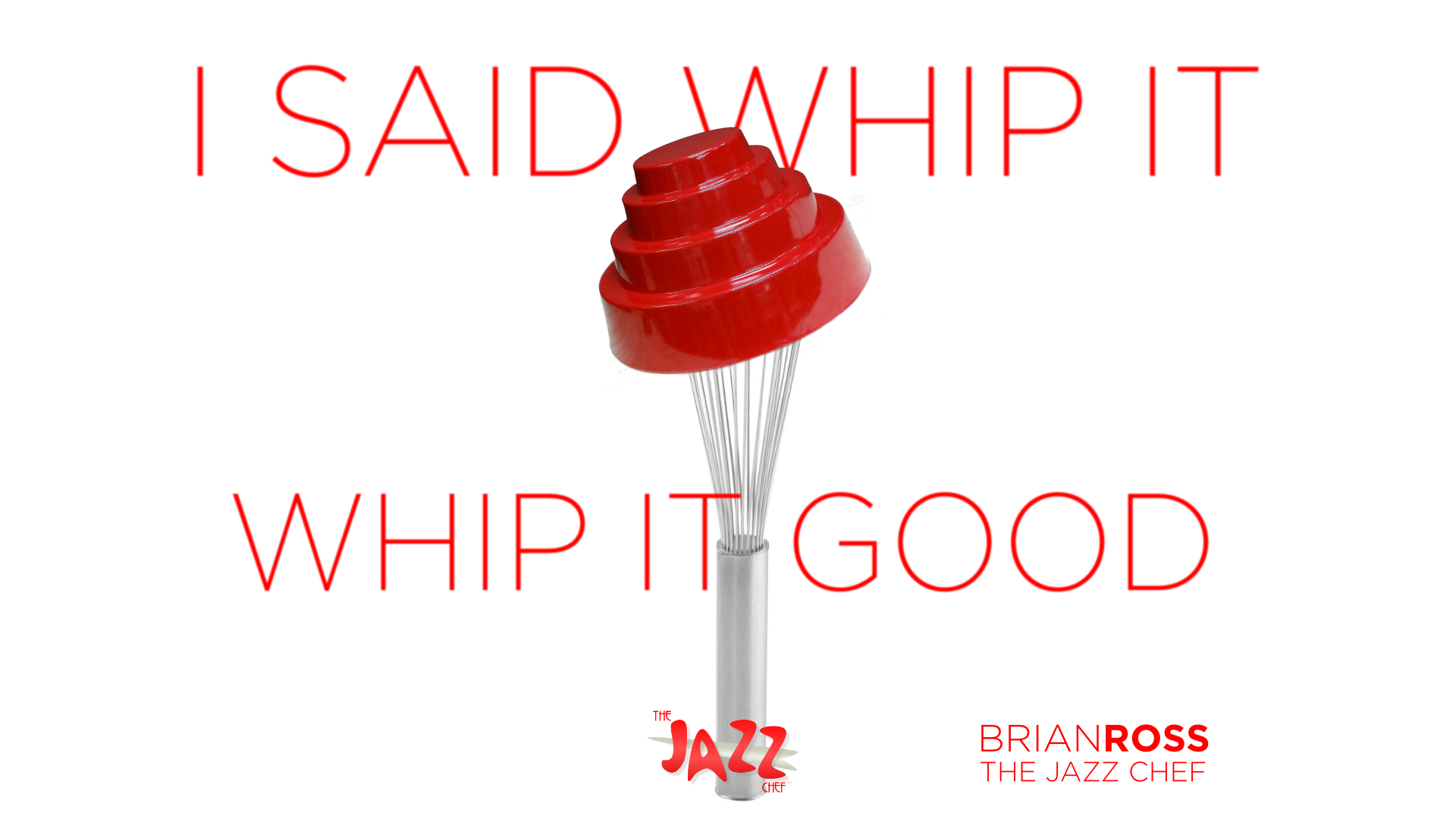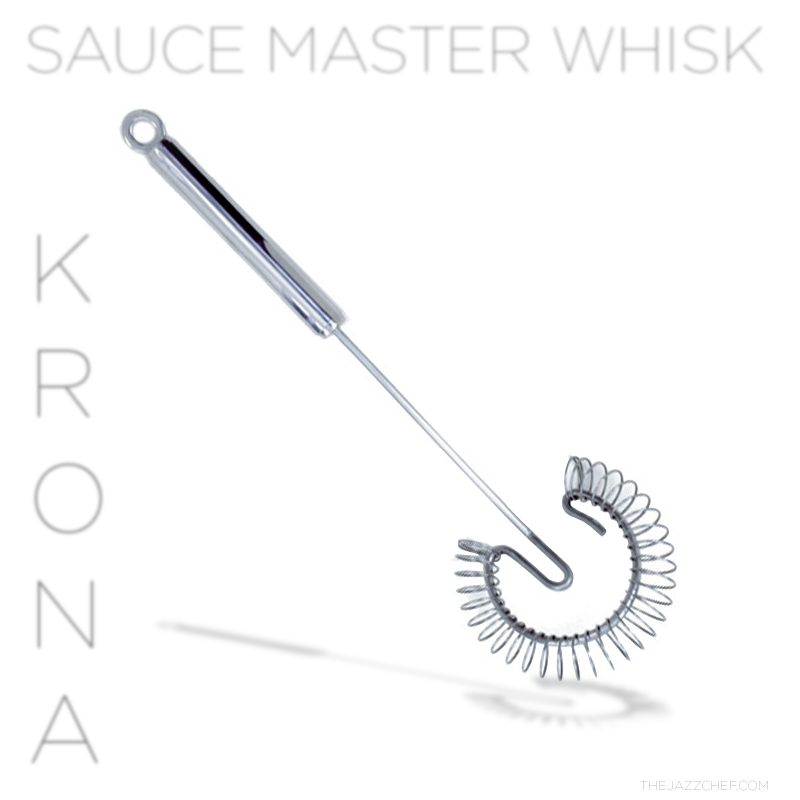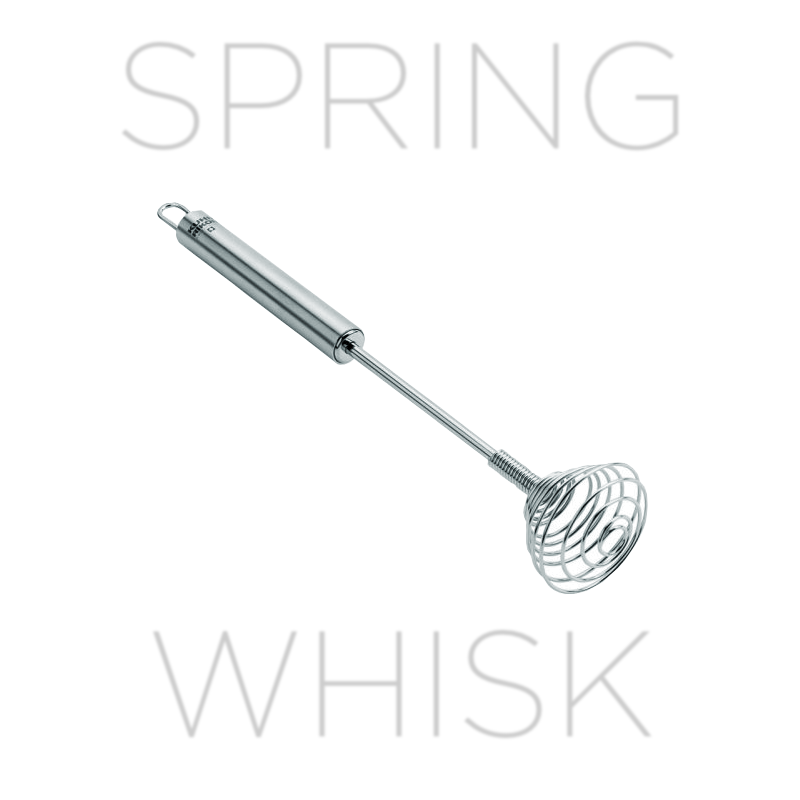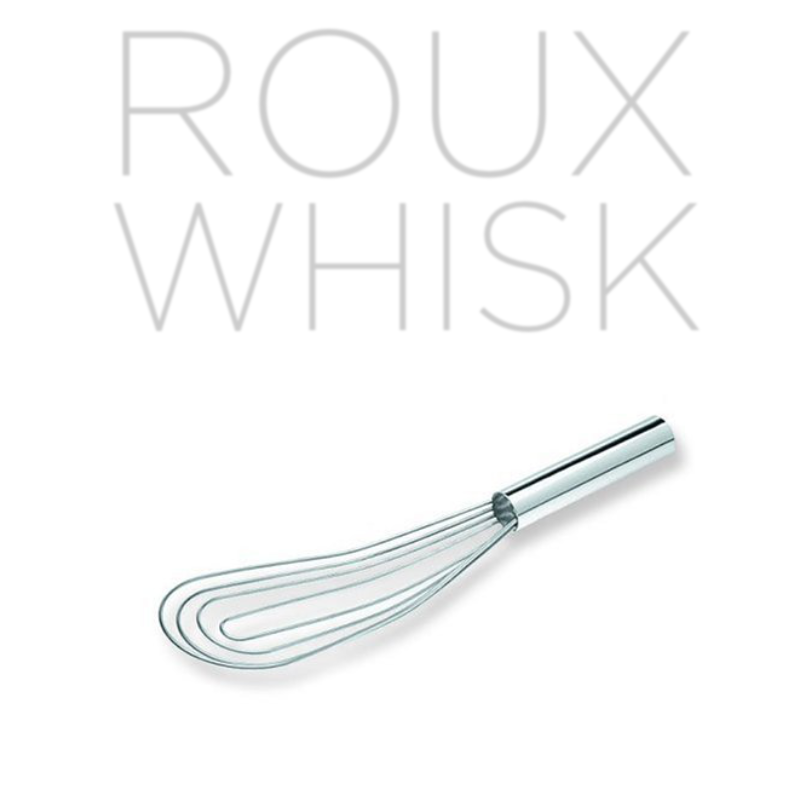Tool tips: Whips & Whisks
Revised 06.02.2024 – Most of y’all think whisks are no big whip (deal). They’re those plastic, loopy things that everyone’s got in their kitchen. You break one? You throw another into your cart, at Ikea, or Target. For some reason, when I think whip, I always scrape a little brain gum, stuck to the roof of my mind, from that 1980’s one-hit-wonder counter-culture band, “DEVO:”
Whip it GOOD!
Whisks, also known as “whips,” in the kitchen trade, are all about aeration and integration.
Beating air into things like whipped cream, or eggs, aeration, gives them a lighter, or more solid mouthfeel.
Controlling how finely ingredients blend (integration) are how you make a great, smooth soup, or an erratically-crumbed muffin.
“That’s what I have a mixer for!”
Sure. That thought is probably rolling around the back of your brain, when you think about whipping up anything.
Go Beyond the Mixer!
The whisk offers something that even the best on/off switch on a KitchenAid mixer can’t: Pressure, degree, and subtlety.
Whips/whisks are the manual mixers.
They blend!
They aerate!
They emulsify!
You can make mixer mayo, but a mayo, or aioli, that is hand-whisked, in small batches, has a flavor that can’t be beat. It also contributes a nice bump in calories burned, to your Fitbit, or Apple Watch!
Homemade mayonnaise is, to the store-bought white glop, what a Wagyu beef burger is to a McDonald’s cheeseburger.
It is a fragile, wonderful, hand-crafted thing. It relies on simple, fresh ingredients that blow the mind, even of the biggest mayo haters.
I know! I used to be one.
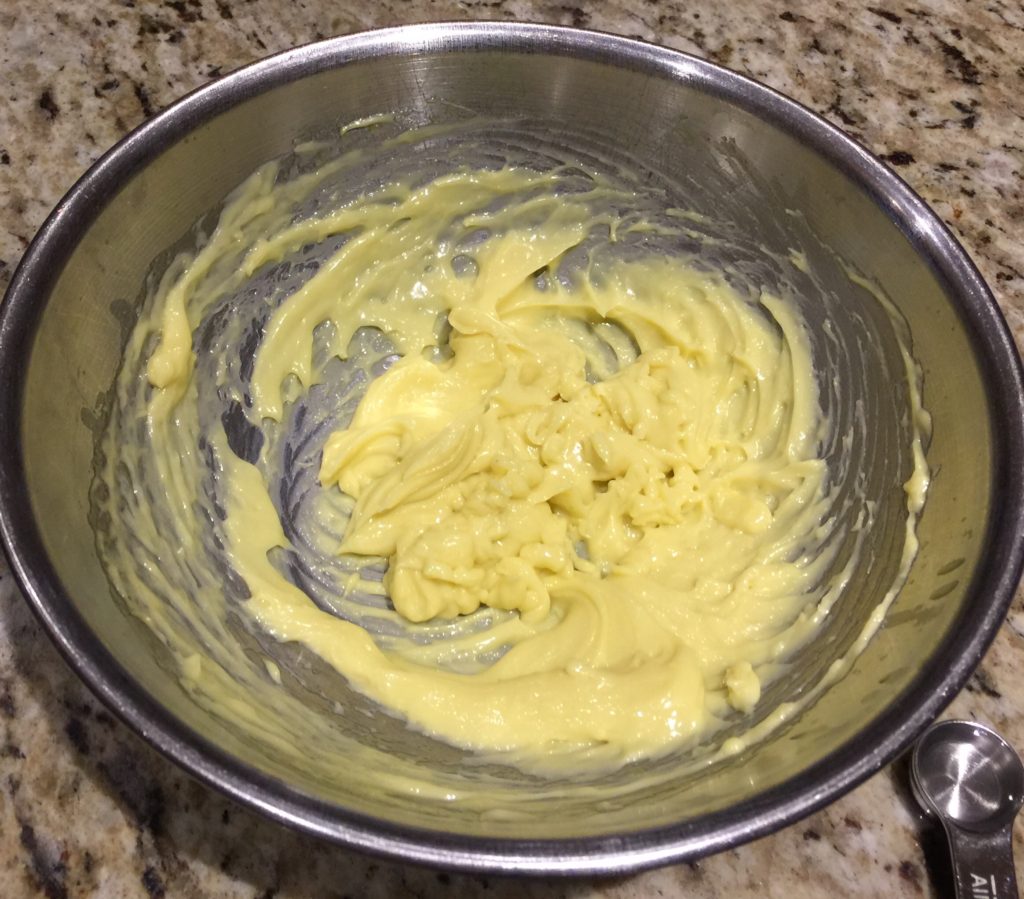
One of the reasons that is so is because the hand-action of whisking requires delicacy, and control.
You paint houses with a sprayer and an air compressor. You paint masterpieces with a brush and a palette.
Where Mixers Work Better
True, the whisk attachment, in a mixer, is great for things like meringues, and whipped creams that need a lot of consistency in the speed of the aeration (Check out my Atlas ‘Never Whipped’ Whipped Cream)
In a whipped cream, the aeration combined with emulsification of the fats and water in the milk cause the cream to form and stand up.
Likewise, in a meringue, the whisk helps aerate the egg white, trap air bubbles in it, which causes it to rise. The beating also stiffens the proteins into forms that trap the air.
Immersion Blenders / Pimer
You can use an immersion blender/pimer in a pot. It will create a very uniform product that would take considerably longer, by hand.
It works at high speed to purée.
It isn’t useful for medium to slow speed applications.
The whisk, then, should be no less important to your culinary creations than your knives as a go-to tool of personal expression.
Like Golf Clubs, what’s going
to be in your “bag?”
Not surprisingly, all whisks are not created equal.
If you play golf, then you get it: You have clubs for distance, for chipping, and for finesse. Whisks are no different. There are different kinds that perform different tasks better.
Like golf clubs, home chefs who “get” whisks can go a little crazy buying them.
They’ll convince themselves that this, or that, specialty whisk is the ONLY way to get Recipe X to turn out.
I’ve seen some whacky and wild whips. I’ve included a couple in this article! While they seem like a great idea, when you’re at your favorite kitchen toy store, or shopping online, they clutter up storage space.
No need to go overboard.
At the minimum, a good kitchen drawer should have three whisks/whips:
MUST-HAVES
For the average house, two to three whips/whisks are essential to your basic “bag” of tools.
If you can only do ONE whisk in your kitchen, the piano whip, AKA balloon whip, is it. A 20cm (8”) to 25cm (10”) size is ideal, for most home uses.
Good for:
- blending
- whipping
- beating
Medium to thick textures. Dry ingredients, or mixtures which are dense clump up between the wires.

French whip, of around 8-12″ in size. Sturdier for heavy items like:
- light doughs
- heavy sauces
(See the warning about buying French whisks below.);
A Norpro Krona Sauce Master whisk is ideal for small jobs that need broad and rapid integration:
- salad dressings
- mayonnaise/aioli
- fruit sauces
- reduction thickening
The small, tight, wires increase the whisk’s efficiency. It also reduces the amount of energy expended.
LAGNIAPPE WHISKS
Spring Whisk
A spring whisk, also called a coil whisk, galaxy whisk, and a few other cute names, is handy for doing quick spot jobs in tight spaces.
Roux Whisk
The spring allows you not only to whip in a small space, but pull upward while whisking to encourage the upward motion. It provides vertical lift as well as centrifugal force.
What’s that good for?
If I have to knock off a small order of whipped cream, rather than dirty up bigger bowls or a mixer, I can ‘whip it good,’ even in a large coffee mug.
Upward pull keeps the emulsification of the fats in the cream lifting, even in the smallest spaces.
Improving contact of the whisk with the material, when making sauces, is particularly good for work in hot pans, hence the “roux.”
It minimizes splatter, unlike a balloon whisk, which reduces burn injuries, and keeps a roux cooking evenly.
When thickening, a gravy is best when the whisk works across a maximum pan surface.
Any time that you need to make contact with a wide field in a pot, mixing bowl, or pan, this is your whisk.
WHACKY WHIPS

There are a lot of weird whips and whisks in the culinary tool universe. Some are works of art. A few are traditions of specific countries. Some may up your coolness factor. Others are cute, fun, and really inefficient.

If you can’t move your arm, this push-spring blender may make some sense. A piano whip does just fine, though.
This brodpisker cuts through dough, without sticking. It’s still a whisk, not a dough cutter. Folds batter, too.

Espresso whisks are totally for upping your coolness factor. This is a pretty nifty one that whisks,

This is my winner in the “whimsical whisks” category. Not efficient, but FUN!

Kuhn-Rikon’s flat whisk is like a Roux Whisk and a Piano Whisk having a baby.

It’s a fork! It’s a whisk! It’s the Fiskie! Our whackiest whisk that still (kinda sorta) works.
Tips on Buying
What are the best-made whisks constructed from?

Go Stainless!
The best whisks are all-stainless steel.
Sure, I’m getting boos from the growing number of producers of silicone whisks. Better on non-stick pans? Slightly. If the owner is a ham-handed whisker, then anything that you scrape across a non-stick surface is going to deteriorate the surface with scuffs.
If you use a whisk with some delicacy though, there is no surface abrasion on most “non-stick” pans.
More important, though, stainless will go in pots, and other high temp containers, that exceed even the highest temp of all nylon, and most of the silicone whisks.
Stainless steel whisks are also fairly inexpensive, well balanced, and easy to use. Depending upon the gauge of the metal wires used, wires don’t sag, warp, have plastic cracking off, or give, under the weight of the foods being mixed as much as cheap plastic, or flexing silicone.
They’re easier to keep clean, too.
Treat them well, and you can practically have them forever.

I tend to prefer the 8” and 10″ variations of most whisks. They do the job and they take up less space. If you use large, industrial size pots that need to have things whisked in them, you’ll find that adding a 16” or 18” balloon whisk may be useful.

French whisks are a pain to use. They always have to be hand-washed, due to the wax core, and dried thoroughly, to be safe to use. Wood handles aren’t ideal, either, for sterility.
Avoid buying old school wax/wood French whisks.
You can tell la difference! They have either wood, or metal handles, with the traditional wax seal. It’s a yellow pasty-looking base, inside the metal seat of the handle.), and
Trés chic? Maybe.


It’s fun to shop at cooking toy stores like Williams-Sonoma® or Sur La Table®, but for a lot of this basic stuff, industrial/commercial whisks, available at Amazon, or commercial restaurant supplies, online, or locally, are cheaper, and better.
You may not get the blingy logo on your whisk, but, as long as it doesn’t get lost in a move, it will be a go-to for the rest of your life.

